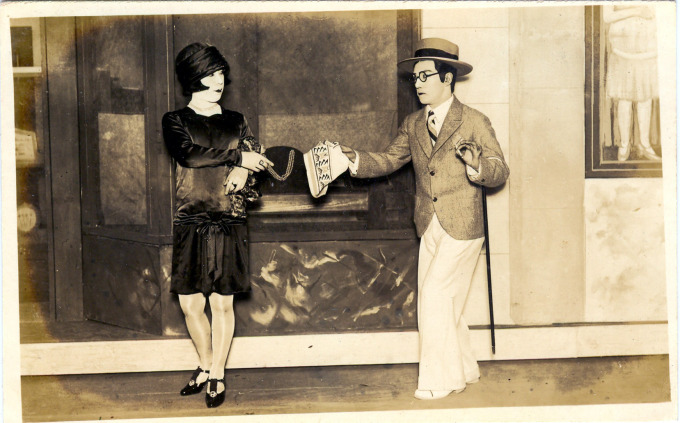“The Modern Girl [‘moga’, from modan (modern) garu (girl)] make only a brief appearance in our histories of prewar Japan. She is a glittering, decadent, middle-class consumer who, through her clothing, smoking and drinking, flaunts tradition in the urban playgrounds of the late 1920s. Arm in arm with her male equivalent, the mobo (Modern Boy), and fleshed out in the Western flapper’s garb of the roaring twenties, she engages in ginbura (Ginza-cruising).
“Yet by merely equating the Japanese Modern Girl with the flapper we do her a disservice, for the Modern Girl was not on a Western trajectory. Moreover, during the modern years when this female, a creation of the mass media, titillated her Japanese audience, she was not easily defined. Who was this Modern Girl? What made her do what she did?
“… First and foremost, the Modern Girl was defined by her body, specifically by her short hair and long, straight legs. In a brief disquisition titled simply ‘Woman’s Legs’, the proletarian writer Kataoka Teppei argued that although other era of Japanese history had been graced by sightly legs, the legs of the Modern Girl were a product of the ability of the human spirit to shape the human form; her legs symbolized the Modern Girl’s growing ability to create new life for women. The author ended his polemic with a hortatory appreciation of the Modern Girl in motion: ‘Onward! Dance! Legs! Legs! Legs!'”
– Erotic Grotesque Nonsense: The Mass Culture of Japanese Modern Times, by Miriam Rom Silverberg, 2009
See also:
Changing Fashion (Swimsuit), c. 1920
Ten Qualifications for Being a ‘Moga’ [Modern girl]
1. Strength, the “enemy” of conventional femininity
2. Conspicuous consumption of Western food and drink
3. Devotion to jazz records, dancing, and smoking Golden Bat cigarettes from a metal cigarette holder
4. Knowledge of the types of Western liquor and a willingness to flirt to get them for free
5. Devotion to fashion from Paris and Hollywood as seen in foreign fashion magazines
6. Devotion to cinema
7. Real or feigned interest in dance halls as a way to show off one’s ostensible decadence to mobo (modern boys)
8. Strolling in the Ginza every Saturday and Sunday night
9. Pawning things to get money to buy new clothes for each season
10. Offering one’s lips to any man who is useful, even if he is bald or ugly, but keeping one’s chastity because “infringement of chastity” lawsuits are out of style– Fujin sekai (Ladies’ World) magazine, 1929



Pingback: "Working Women", c. 1920. | Old Tokyo